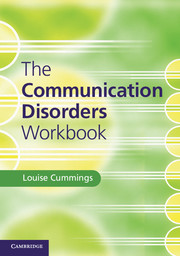Book contents
- Frontmatter
- Contents
- Preface
- Acknowledgements
- List of data analysis exercises
- Chapter 1 Introduction to communication disorders
- Chapter 2 Developmental speech disorders
- Chapter 3 Developmental language disorders
- Chapter 4 Communication disorders in mental illness
- Chapter 5 Acquired speech disorders
- Chapter 6 Acquired language disorders
- Chapter 7 Disorders of voice
- Chapter 8 Disorders of fluency
- Chapter 9 Hearing disorders
- Answers to questions and exercises
- Glossary
- References
- Index
- References
Chapter 6 - Acquired language disorders
Published online by Cambridge University Press: 05 June 2014
- Frontmatter
- Contents
- Preface
- Acknowledgements
- List of data analysis exercises
- Chapter 1 Introduction to communication disorders
- Chapter 2 Developmental speech disorders
- Chapter 3 Developmental language disorders
- Chapter 4 Communication disorders in mental illness
- Chapter 5 Acquired speech disorders
- Chapter 6 Acquired language disorders
- Chapter 7 Disorders of voice
- Chapter 8 Disorders of fluency
- Chapter 9 Hearing disorders
- Answers to questions and exercises
- Glossary
- References
- Index
- References
Summary
Adults can sustain injuries and illnesses which cause disruption of previously intact language skills. Aphasia is the most prominent language disorder which is acquired in adulthood. Typically, it is caused by damage to the language centres in the left hemisphere of the brain following a cerebrovascular accident or stroke. Less common causes of aphasia are traumatic brain injury, brain tumours and cerebral infections. In rare cases, aphasia may result from damage to the right hemisphere of the brain. Aphasias are classified as fluent and non-fluent types. In fluent aphasia, there is effortless spoken output which exhibits the normal suprasegmental features of speech. However, this output often contains copious amounts of jargon (hence, the term ‘jargon aphasia’) in which neologisms are present. The client with fluent aphasia also has a severe auditory comprehension deficit and displays limited awareness of their communication problems. In non-fluent aphasia, there is reduced, effortful spoken output. The client is aware of, and is often distressed by, their problems with spoken language. Grammatical structure is markedly reduced with content words (e.g. nouns) retained, while function words (e.g. articles) are omitted. This gives speech the appearance of a telegram (hence, the use of the term ‘agrammatic aphasia’ to describe this type of aphasia).
Damage to the right hemisphere of the brain can cause a different type of language disorder in adults. In so-called right-hemisphere language disorder, structural language skills are largely intact while there are marked impairments of pragmatic and discourse skills. These impairments include the concrete, literal interpretation of figurative language, egocentric discourse which relates the speaker's personal experience, neglect of the hearer's perspective in formulating utterances, and problems with topic management and narrative structure. Many of these communication difficulties appear to be related to cognitive deficits such as executive dysfunction.
- Type
- Chapter
- Information
- The Communication Disorders Workbook , pp. 88 - 110Publisher: Cambridge University PressPrint publication year: 2014



